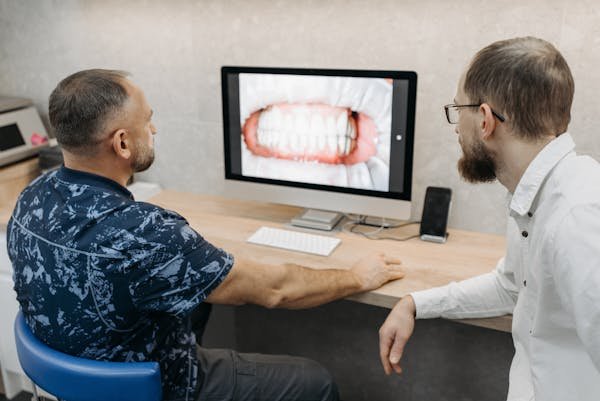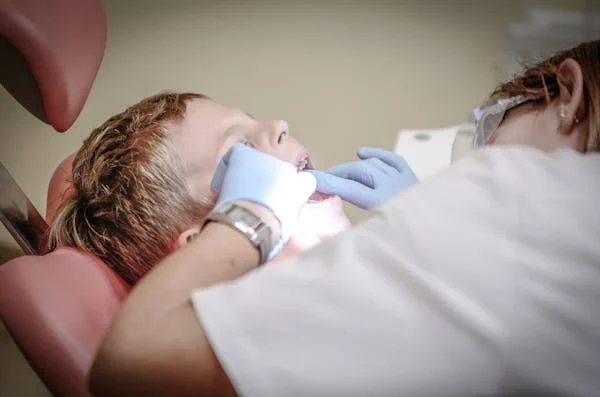In today’s digital world, dentists can no longer rely solely on word-of-mouth referrals and traditional advertising methods. Social media has become a powerful tool for businesses of all types, including dental practices. By effectively using social media, dentists can attract new patients, retain existing ones, and build a strong online presence. In this article, we’ll explore how dentists can leverage social media marketing to grow their practices and connect with their communities.
Building Your Social Media Presence

The foundation of a successful social media marketing strategy is a robust and engaging online presence. This section will provide more strategic and actionable advice for startup dental practices looking to build and enhance their social media presence.
Choosing the Right Platforms
Not all social media platforms are created equal, and it’s crucial to choose the ones that best fit your practice’s goals and target audience. Here’s how to make strategic choices:
Identify Your Target Audience: Understand the demographics of your ideal patients. Younger audiences might be more active on Instagram and TikTok, while older demographics might prefer Facebook. Professionals might be found on LinkedIn.
Evaluate Platform Features: Each platform offers unique features that can be leveraged differently. Instagram’s visual focus is perfect for showcasing before-and-after photos, while Facebook’s community features are ideal for engaging with local audiences. LinkedIn can be used to share professional insights and network with other healthcare providers.
Assess Resource Availability: Consider your resources, including time and budget. Managing multiple platforms requires consistent effort. It’s better to master a few platforms than spread yourself too thin across many.
Setting Up Professional Profiles
Your social media profiles are often the first impression potential patients will have of your practice. Here’s how to ensure they’re professional and inviting:
Consistent Branding: Use a consistent profile picture (such as your logo or a professional headshot), color scheme, and bio across all platforms. This helps create a cohesive and recognizable brand.
Complete Your Profiles: Fill out all the profile sections thoroughly. Include your contact information, address, office hours, and a link to your website. This makes it easy for potential patients to find and contact you.
Craft a Compelling Bio: Your bio should clearly communicate who you are, what you offer, and what sets your practice apart. Use keywords related to dental services to improve searchability.
Content Strategy Development
A strategic content plan ensures that your social media efforts are consistent and effective. Here’s how to develop a content strategy tailored to your dental practice:
Content Pillars: Identify key themes or topics that reflect your practice’s expertise and patient interests. Common pillars for dentists include oral health education, patient testimonials, behind-the-scenes looks at your practice, and promotional offers.
Content Calendar: Plan your posts in advance using a content calendar. This helps maintain consistency and ensures that you cover all your content pillars regularly. Tools like Hootsuite or Buffer can help schedule posts.
Visual Content: Invest in high-quality images and videos. Professional photos of your office, staff, and services can make a significant impact. Consider hiring a professional photographer periodically.
Leveraging Advanced Features
Social media platforms offer advanced features that can enhance your engagement and reach. Here’s how to strategically use them:
Live Streaming: Host live Q&A sessions, dental health webinars, or live tours of your office. Live videos can boost engagement and provide real-time interaction with your audience.
Stories and Reels: Use Instagram and Facebook Stories for short, engaging content that disappears after 24 hours. Reels can showcase quick tips, behind-the-scenes snippets, or patient testimonials in a dynamic format.
Hashtags and Geotags: Use relevant hashtags to increase the visibility of your posts. Local hashtags can attract potential patients in your area. Geotagging your location can also help local users find your practice.
Collaborations and Takeovers: Partner with local businesses or influencers for collaborations. For example, a local gym might team up with you to promote dental health among its members. Social media takeovers, where an influencer or partner takes control of your account for a day, can introduce your practice to a new audience.
Analytics and Optimization
Finally, continuously track and optimize your social media efforts to ensure they are effective.
Use Analytics Tools: Most social media platforms offer built-in analytics tools. Use these to track metrics like engagement, reach, and follower growth. Tools like Google Analytics can track traffic to your website from social media.
Adjust Your Strategy: Regularly review your analytics to understand what content performs best. Use this data to adjust your strategy, focusing more on what works and less on what doesn’t.
A/B Testing: Experiment with different types of content, posting times, and formats to see what resonates most with your audience. A/B testing can help refine your approach and improve results over time.
Building a strong social media presence is a dynamic and ongoing process. By choosing the right platforms, setting up professional profiles, developing a strategic content plan, leveraging advanced features, and continuously optimizing your efforts, your dental practice can effectively use social media to attract and engage patients, build your brand, and grow your practice.
Creating Engaging Content
Creating engaging content is the heart of any successful social media marketing strategy. For dental practices, this means sharing content that not only attracts but also retains your audience’s attention. Here are some strategic and highly actionable tips to help startup dental practices create content that resonates with their audience.
Storytelling
Storytelling is a powerful tool in content marketing. It helps humanize your practice and connect with your audience on a personal level.
Patient Journeys: Share stories of patients who have had significant transformations. For example, document the journey of a patient who received orthodontic treatment or a smile makeover. Ensure you have their permission and maintain their privacy.
Staff Spotlights: Introduce your team through stories. Share why they chose dentistry, their professional journey, and what they love about their job. This builds a personal connection and showcases the friendly faces patients will meet.
Daily Life in the Practice: Share a day in the life at your dental practice. Highlight different procedures, interactions, and behind-the-scenes moments. This can demystify dental visits and make your practice seem more approachable.
User-Generated Content
Encouraging your patients to create content for your practice can significantly boost engagement and trust.
Photo Contests: Run photo contests where patients share their best smile selfies. Offer a prize for the best photo to encourage participation. This not only generates content but also spreads word-of-mouth awareness.
Reviews and Testimonials: Ask satisfied patients to share their experiences on social media. Feature these reviews and testimonials on your profiles. This adds authenticity and builds trust with potential patients.
Hashtag Campaigns: Create a unique hashtag for your practice and encourage patients to use it when they post about their visits. This can help build a sense of community and make it easier to find user-generated content.
Educational Series
Educational content establishes you as an expert and provides value to your audience.
Weekly Tips: Share weekly dental health tips. These can be simple reminders about brushing and flossing or more detailed advice on topics like diet and oral health. Consistent tips can keep your audience coming back for more.
Myth Busting: Address common dental myths and misconceptions. Create content that debunks these myths with factual information. This can be particularly engaging and shareable.
Procedure Spotlights: Create detailed posts or videos explaining different dental procedures. Use simple language and visuals to make complex procedures understandable. This can help reduce patient anxiety and increase trust in your expertise.
Interactive Content
Interactive content can significantly boost engagement and make your social media profiles more dynamic.
Polls and Quizzes: Use polls and quizzes to engage your audience. For example, you could create a quiz about dental hygiene habits or a poll asking about favorite toothpaste brands. These can be fun and informative.
Live Q&A Sessions: Host live Q&A sessions where you answer common dental questions. Promote these sessions in advance to build anticipation. Live interactions can create a sense of immediacy and personal connection.
Virtual Tours: Offer virtual tours of your office. Use interactive tools to allow potential patients to explore your practice online. This can make your practice feel more accessible and welcoming.
Seasonal and Topical Content
Aligning your content with seasons and trending topics can make it more relevant and engaging.
Seasonal Tips: Share dental health tips relevant to different seasons. For example, summer tips might focus on protecting teeth from sports injuries or managing the effects of pool chlorine.
Holiday Specials: Create content around holidays and special events. Offer promotions for Valentine’s Day, back-to-school season, or National Dental Hygiene Month. Use festive themes and visuals to attract attention.
Current Events: Tie your content to current events or trending topics. For instance, if there’s a popular new food trend, discuss its impact on dental health. This shows that your practice is up-to-date and relevant.
Content Optimization
To maximize the impact of your content, it’s important to continuously optimize your approach.
Analyze Performance: Regularly review the performance of your posts. Look at metrics such as likes, shares, comments, and reach. Identify which types of content perform best and adjust your strategy accordingly.
A/B Testing: Experiment with different content formats, posting times, and messaging styles. Conduct A/B tests to see which variations resonate most with your audience. This can provide valuable insights and improve your content strategy over time.
Stay Consistent: Consistency is key in content marketing. Maintain a regular posting schedule and ensure that your content aligns with your brand’s voice and values. Consistent quality and frequency help build trust and keep your audience engaged.
Creating engaging content for social media is an ongoing process that requires creativity, strategy, and a deep understanding of your audience. By leveraging storytelling, user-generated content, educational series, interactive content, and optimizing your approach, your dental practice can effectively use social media to attract and retain patients, build your brand, and grow your practice.
Engaging with Your Audience
Engaging with your audience is crucial for building a loyal and interactive community around your dental practice. This involves more than just responding to comments; it requires strategic and proactive efforts to create meaningful interactions. Here’s how to do it effectively.
Personalized Interactions
Personalizing your interactions can significantly enhance the connection you have with your audience.
Respond to Comments with Personal Touches: When responding to comments, use the commenter’s name and address their specific points. This makes your responses feel more genuine and personal. For example, if a patient comments about their positive experience, thank them specifically and mention a detail from their visit.
Celebrate Milestones with Patients: Acknowledge and celebrate milestones like a patient’s first visit anniversary, birthdays, or the completion of a treatment plan. A simple personalized message or shout-out on social media can make patients feel valued and appreciated.
Send Direct Messages: For more private or detailed conversations, use direct messages. This can be particularly useful for addressing specific concerns or following up on patient queries.
Hosting Virtual Events
Virtual events can provide a platform for real-time interaction and offer immense value to your audience.
Webinars and Live Q&As: Host webinars on topics like dental health tips, new treatments, or general Q&A sessions. Promote these events in advance to ensure good attendance. Use these sessions to address common questions and concerns, which can position you as a trusted expert.
Virtual Open Houses: Organize virtual open house events where potential patients can learn about your practice, meet the team, and ask questions. This can be especially useful for new practices looking to build a local presence.
Interactive Workshops: Conduct workshops on dental care routines, particularly aimed at specific groups like parents with young children or the elderly. Interactive elements like quizzes and live demonstrations can make these sessions more engaging.
Creating Community Engagement Initiatives
Building a sense of community around your practice can foster loyalty and long-term engagement.
Community Challenges: Launch challenges that encourage community participation, such as a “Best Smile Challenge” where patients share their smile photos. Offer incentives like free dental check-ups or whitening sessions for winners.
Support Local Causes: Partner with local charities or community events. Share your involvement on social media and encourage your followers to participate. This not only helps the community but also enhances your practice’s image as a community-oriented business.
Patient Appreciation Days: Host virtual or in-person patient appreciation events. Use social media to promote these events and share highlights. This can strengthen the bond between your practice and your patients.
Leveraging User-Generated Content
User-generated content (UGC) can be a powerful tool for engagement and social proof.
Feature Patient Stories: Encourage patients to share their dental health journeys on their own social media and tag your practice. Repost these stories on your profiles, giving a shout-out to the patient. This not only provides authentic content but also makes patients feel valued.
Create UGC Campaigns: Launch campaigns where patients share specific types of content, such as their favorite dental care tips or photos with your branded swag. Feature the best submissions on your profiles.
Patient Takeovers: Occasionally, let a patient take over your social media for a day to share their experiences and perspectives. This unique content can attract significant interest and engagement.

Encouraging and Managing Reviews
Online reviews play a critical role in your practice’s reputation and patient acquisition.
Proactively Ask for Reviews: After a positive patient interaction, request a review. Make it easy by providing direct links to your review pages on platforms like Google, Facebook, and Yelp.
Respond to Reviews: Always respond to reviews, both positive and negative. Thank patients for their positive feedback and address any concerns raised in negative reviews. Show that you value all feedback and are committed to improving your services.
Highlight Positive Reviews: Share glowing reviews on your social media profiles. Use these as testimonials to build credibility and trust with potential patients.
Utilizing Interactive Content
Interactive content can drive higher engagement by involving your audience directly.
Polls and Surveys: Regularly post polls and surveys to gather opinions on various topics, such as favorite dental products or preferred appointment times. This not only engages your audience but also provides valuable insights.
Contests and Giveaways: Organize contests and giveaways that require audience participation, such as photo contests or trivia quizzes. Ensure that the prizes are relevant to your practice, like free cleanings or dental care kits.
Interactive Stories and Reels: Use Instagram and Facebook Stories to create interactive content, such as Q&A stickers, polls, and quizzes. These features encourage followers to interact with your content in real-time.
Engaging with your audience on social media requires a thoughtful and strategic approach. By personalizing interactions, hosting virtual events, creating community initiatives, leveraging user-generated content, managing reviews, and utilizing interactive content, your dental practice can build a strong and loyal online community. This, in turn, will help attract new patients and retain existing ones, contributing to the growth and success of your practice.
Analytics and Optimization
Understanding and optimizing your social media efforts through analytics is essential for sustained success. Here’s how you can strategically use data to improve your social media marketing as a dental practice.
Setting Measurable Goals
Establish clear, measurable goals for your social media efforts. This will help you track progress and determine what’s working.
SMART Goals: Ensure your goals are Specific, Measurable, Achievable, Relevant, and Time-bound. For example, aim to increase your Instagram followers by 20% over the next three months or boost engagement rates on Facebook posts by 15% within six months.
Key Performance Indicators (KPIs): Identify key metrics that align with your goals. These might include follower growth, engagement rate, website traffic from social media, or new patient inquiries generated through social media channels.
Utilizing Analytics Tools
Take advantage of the built-in analytics tools offered by social media platforms and third-party tools to gain insights into your performance.
Platform Analytics: Use Facebook Insights, Instagram Insights, Twitter Analytics, and LinkedIn Analytics to track metrics like reach, engagement, and audience demographics. These tools provide valuable data on how your content is performing and who is engaging with it.
Google Analytics: Track the traffic from social media to your website using Google Analytics. Set up goals to measure conversions, such as appointment bookings or contact form submissions, to see how social media efforts translate into tangible results.
Third-Party Tools: Consider using tools like Hootsuite, Buffer, or Sprout Social for more in-depth analytics and reporting. These tools offer advanced features such as sentiment analysis, competitor benchmarking, and customizable reports.
Data-Driven Content Strategy
Use the data from your analytics to refine and optimize your content strategy.
Identify Top-Performing Content: Look for patterns in your analytics to determine what types of content resonate most with your audience. Is it educational videos, patient testimonials, or behind-the-scenes photos? Focus on creating more of the content that performs well.
Optimize Posting Times: Analyze when your audience is most active and adjust your posting schedule accordingly. Posting during peak times can increase the likelihood of your content being seen and engaged with.
Audience Insights: Use demographic data to better understand your audience. Tailor your content to match the interests and preferences of your followers. For example, if your audience is predominantly young adults, focus on topics and formats that appeal to that age group.
A/B Testing
A/B testing involves creating two versions of a piece of content to see which one performs better. This can help you make informed decisions based on actual data.
Test Different Formats: Experiment with different content formats, such as images vs. videos, long-form posts vs. short captions, or text-based posts vs. infographics. Analyze the results to see which formats generate the most engagement.
Test Messaging: Try different headlines, calls-to-action, or tone of voice in your posts. For example, you might test a friendly, conversational tone against a more professional, informative tone to see which resonates more with your audience.
Test Timing: Post the same content at different times of the day or on different days of the week to determine the optimal posting schedule for maximum reach and engagement.
Continuous Improvement
Social media marketing is an ongoing process that requires continuous monitoring and improvement.
Regular Review Meetings: Schedule regular meetings to review your social media performance. Discuss what’s working, what’s not, and any new trends or changes in the social media landscape that might impact your strategy.
Adjust Strategy: Be flexible and willing to adjust your strategy based on your findings. If a particular type of content isn’t performing well, pivot to new ideas and approaches.
Stay Updated: Social media platforms frequently update their algorithms and features. Stay informed about these changes and adjust your strategy accordingly. Follow industry blogs, attend webinars, and participate in professional groups to stay current.
Building a Social Media Community

Creating a community around your dental practice can lead to long-term engagement and loyalty.
Fostering a Sense of Belonging
Create a Facebook Group: Consider creating a private Facebook group for your patients where they can ask questions, share experiences, and support each other. This can create a sense of belonging and encourage active participation.
Host Community Events: Use social media to promote and organize community events such as dental health fairs, free check-up days, or educational seminars. Encourage your followers to attend and share their experiences online.
Showcase Patient Stories: Regularly feature patient stories and testimonials on your social media profiles. Highlighting real patients creates a sense of community and trust.
Encouraging User Engagement
Ask Questions: Prompt your followers to engage by asking questions in your posts. Questions about their dental care routines, favorite dental products, or general health tips can spark conversations.
Interactive Posts: Use interactive content like polls, quizzes, and challenges to engage your audience. For example, a weekly dental trivia quiz can be a fun way to educate and engage your followers.
Celebrate Patient Achievements: Celebrate your patients’ achievements, whether it’s completing a dental treatment or maintaining excellent oral hygiene. Public recognition can boost engagement and loyalty.
Leveraging Influencers and Partnerships
Collaborating with local influencers and businesses can expand your reach and credibility.
Local Influencers: Partner with local influencers who align with your practice’s values. They can share their positive experiences with your practice and reach a broader audience.
Business Partnerships: Collaborate with local businesses to cross-promote services. For example, a partnership with a local gym could involve mutual promotions where gym members get a discount on dental check-ups and vice versa.
Health Campaigns: Participate in or create health campaigns in collaboration with other healthcare providers. For instance, a “Healthy Smile” campaign in partnership with a nutritionist can highlight the link between diet and dental health.
Engaging with your audience on social media is an essential part of building a successful dental practice. By setting measurable goals, utilizing analytics tools, optimizing your content strategy, conducting A/B testing, fostering a sense of community, encouraging user engagement, and leveraging influencers and partnerships, you can create a thriving online presence that attracts and retains patients. Continuous improvement and a strategic approach will ensure your social media marketing efforts contribute to the growth and success of your dental practice.
Conclusion
Leveraging social media marketing can transform how your dental practice connects with patients and the community. By building a strong social media presence, creating engaging and diverse content, actively engaging with your audience, and utilizing analytics to optimize your strategy, you can establish your practice as a trusted and approachable brand.
Engagement is key. Personalizing interactions, hosting virtual events, creating community initiatives, and encouraging user-generated content help build a loyal and interactive following. Additionally, the use of analytics and A/B testing ensures your efforts are data-driven and continually improving.
Read Next:
- The Importance of SEO in B2C Marketplaces
- Introduction to SEO for B2C Businesses
- Must-Have SEO Tools for Educational Websites
- Google Analytics for Educational Websites: A Tutorial
- Using Local Keywords Effectively in Educational SEO






















Comments are closed.